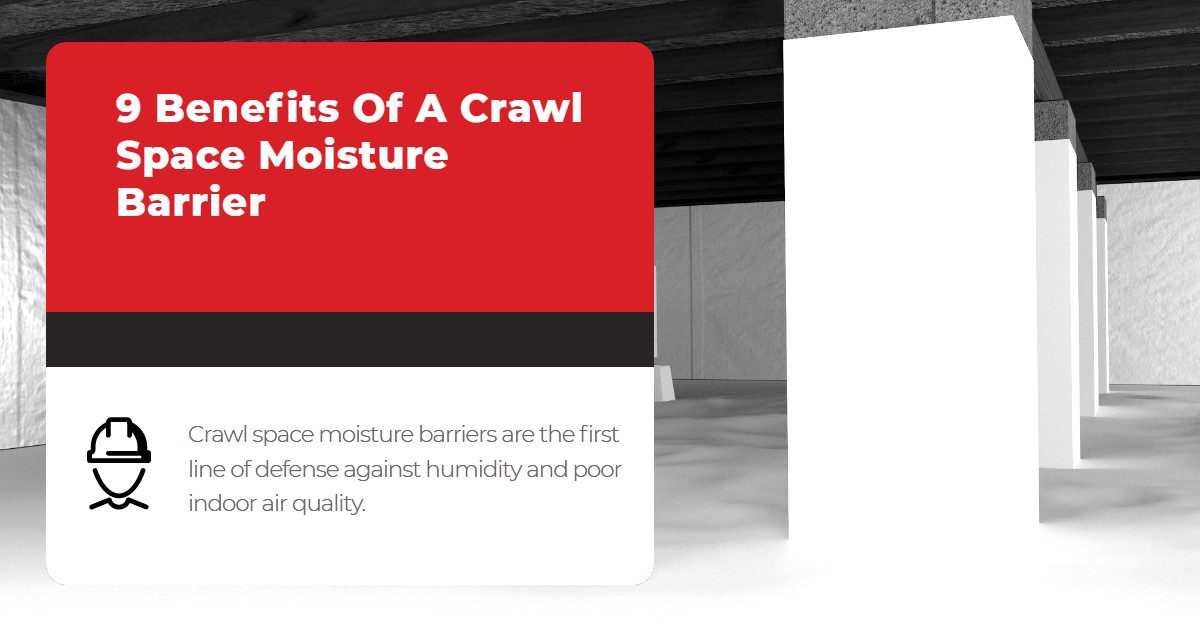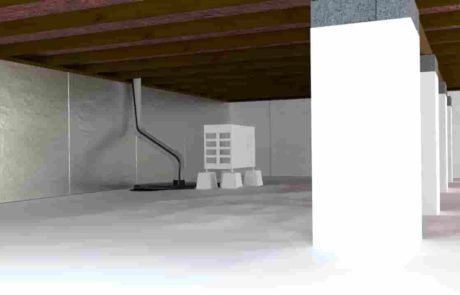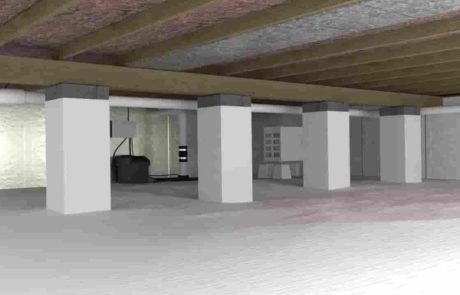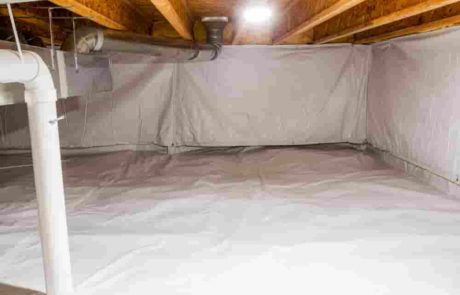If you’re wondering how a crawl space moisture barrier can help your home, you’re in the right place. In this article, you’ll learn what a crawl space moisture barrier is, the different reasons your crawl space is humid, nine benefits of using a crawl space moisture barrier, and other crawl space insulation methods.
What Is A Crawl Space Moisture Barrier?
A crawl space moisture barrier, also called a vapor barrier, falls under the category of crawl space encapsulation. Encapsulation is when your entire crawl space walls and floors are sealed using a thin 10 to 20-mil thick polyethylene sheeting. This sheeting prevents moisture from seeping through your crawl space walls and channels water to a drain tile system where it’s carried away.
Crawl space moisture barriers are the first line of defense against humidity and poor indoor air quality. Did you know that you breathe the air from the floor below you? It’s estimated that 40% of your crawl space air enters the rest of your home. So if your crawl space is humid or smells musty, you will soon begin to breathe that air on your ground floor.
Reasons Your Crawl Space Is Humid/Wet
Here are three reasons why your crawl space is humid/wet.
1. Bulk Water – If you’re noticing a lot of standing water or puddles in your crawl space, you could either have a drainage problem or a plumbing leak. Whatever the case, standing water leads to mold growth, wood rot, mildew, and worse.
2. Moisture Evaporation – The soil underneath your home is prone to absorbing and evaporating water in the air. Your foundation walls, which are usually made of porous concrete, can also evaporate moisture.
3. Outside Air – Some crawl spaces have vents meant to allow air to circulate underneath your home. These are very counterproductive. During hotter months, humid air will enter your crawl space and cause humidity levels to increase. Then, during the colder months, cold air can freeze your plumbing pipes. Most experts recommend sealing any crawl space vents that you may have.
Read more: Learn How To Drain Water Away From Your Foundation.
9 Benefits Of A Crawl Space Moisture Barrier
Below are nine benefits that come with installing a crawl space moisture barrier.
1. It prevents mold and mildew – In order to grow and thrive, mold needs at least 70% relative humidity levels. Breathing in mold can lead to serious allergic reactions such as lung irritation, headaches, skin rashes, and more.
2. It prevents water damage – If you are storing things in your crawl space, such as boxes or tools, a moisture barrier will prevent them from becoming soaked with water. By adding a crawl space moisture barrier, you can add a brand new dry storage space.
3. It prevents musty odors – As we said earlier, you breathe the air from the floor below you. If you want to make sure your home’s air is fresh and clean, install a crawl space moisture barrier.
4. It prevents condensation – Once moisture starts to build up in your crawl space, you will start to notice dew on your walls and beams.
5. It helps prevent damage to your hardwood floors – If you have hardwood floors above your crawl space, moisture can seriously damage them. A moisture barrier can help prevent your expensive flooring from buckling, warping, or bending.
6. It helps with humidity – The ideal crawl space humidity level is around 50% to 55%. Anything higher will promote mold growth and mildew.
7. It helps prevent insect infestations – Small bugs like sewer flies and fruit flies love to breed and nest in puddles of water. If you want to avoid any pests from coming into your home, consider installing a crawl space moisture barrier.
8. It helps prevent wood rot – The wooden beams and joists above your crawl space are vital parts of your home’s structural system. Once wood rot sets in, you can be looking at more than just crawl space issues.
9. It helps with your utility bill – The air from your crawl space will make its way to the floor above it. If that air is too hot or cold, your air conditioning/heat will kick on and attempt to counter the sudden temperature change. Installing a crawl space moisture barrier will help regulate the air in your crawl space and, therefore, the rest of your home.
Other Crawl Space Insulation Methods
Experts recommend installing more than just a crawl space moisture barrier. You can create the ideal crawl space by installing a moisture barrier, along with a drain tile system, sump pump, and dehumidifier.
- Drain tile system – A drain tile system is a series of perforated pipes that collect gathering water and carry it to your sump pit.
- Sump pump – A sump pump is a fixture that sits in your crawl space floor. Sitting inside the sump pit, the sump pump will activate once water reaches a certain level. Then all the collected water will eject out of your home using a discharge line.
- Dehumidifier – A crawl space dehumidifier is a fixture that helps circulate air inside your crawl space. As a warning, you don’t need a dehumidifier if you have open crawl space vents. Otherwise, you’ll constantly be dehumidifying outside air.
- Closing crawl space vents – If your crawl space is equipped with open vents, it might be time to consider closing them. By keeping outside air out, you can help prevent moisture buildup. Some areas require vents to be open during the warmer months and closed during the colder months. So we recommend checking with your local building codes before you start closing them. Read more: Are Crawl Space Vent Covers A Bad Idea?
Who Can Install A Crawl Space Moisture Barrier?
If you need professional solutions and professional service, who should you call? Get in touch with Foundation Professionals of Florida! We’re an award-winning and top-performing company servicing Florida, Georgia, Alabama, Mississippi, Louisiana, Tennessee, Kentucky, North Carolina, South Carolina, Virgin Islands, and the Florida Keys. We also provide foundation repair, basement waterproofing, concrete leveling, and more.




